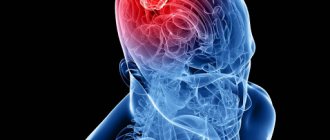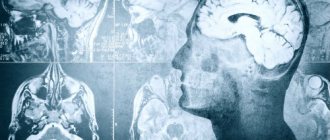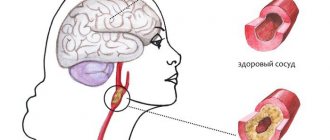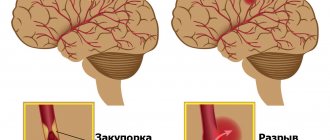The brain is a complex organ that controls all the vital functions of our body - thoughts, speech and body movement. The formation of a brain tumor and its treatment often leads to significant changes in these processes for life. Therefore, it is very important to detect the development of a neoplasm in a timely manner.
In this article, we tell you how to recognize brain cancer: what you should pay attention to, when it’s time to make an appointment with a doctor, whether brain cancer can be cured, what methods of diagnosing and treating this disease exist.
Brain tumors and their symptoms
Brain tumors refer to a whole group of diseases that develop in the brain or internal structures of the cranial cavity. They account for about 6% of all types of neoplasms in the human body.
The risk of developing a brain tumor increases with age; according to statistics, the majority of patients with this pathology are people who have crossed the 40-year mark. Although there are types of tumor-like formations that are diagnosed only in children.
In addition to age, other risk factors for developing brain tumors include:
- presence of traumatic brain injuries;
- bad ecology;
- radiation exposure and exposure to toxic substances in the workplace;
- disruption of intrauterine development leading to congenital tumors;
- family predisposition to genetic mutations.
Tumor-like formations in the brain are usually divided into benign and malignant.
Distinctive features of benign tumors are slow development without germination into neighboring tissue structures and organs, and the absence of metastasis. After their removal there is no relapse.
Malignant tumors are more aggressive and tend to return even after treatment. In addition, brain tumors are also usually classified as primary or secondary tumors. The development of the primary begins from brain tissue, and the secondary is the result of metastasis from any organ.
Signs of brain tumors are very diverse, their manifestations are determined by the size, location and speed of development of the pathology.
Let us dwell on the general symptoms that are characteristic of many tumor-like formations:
- Headache. Almost all patients complain of periodic headaches, although they do not assume that it may be the result of tumor growth.
- Muscle spasms and cramps . This is the most common phenomenon in cases of dysfunction of the central nervous system due to a tumor process in the brain.
- Feeling of nausea, vomiting . Due to increased intracranial pressure, the patient experiences nausea in the morning, which is not associated with indigestion.
- Visual impairment. Brain tumors can affect the optic nerves, so the patient experiences a gradual deterioration of vision.
- Personal changes. The location of a tumor-like formation in a certain part of the brain leads to mental disorders.
- Problems with speech and hearing . Loss of communication skills is associated with tumors in the frontal and parietal lobes of the brain.
- Memory impairment . Patients complain of problems with remembering and memory loss.
- Weakness and fatigue . Brain tumors lead to exhaustion of the body, the patient experiences constant physical fatigue.
- Difficulty maintaining coordination of movements . With the development of tumor-like formations in the brain, the patient’s balance when walking and coordination of arms and legs is impaired.
- Endocrine disorders . Tumors affecting the pituitary gland lead to hormonal imbalances.
Even at the slightest suspicion of the development of a tumor-like formation, it is necessary to immediately undergo examination, and if the diagnosis is confirmed, begin therapeutic procedures. Treatment of malignant brain tumors cannot be delayed, as this may negatively affect the results of therapy. Modern foreign clinics have advanced technological resources to successfully deal with various types of intracranial formations. It is necessary to take into account: any brain surgery is a complex process that requires high professionalism of a doctor, even with ultra-modern equipment. If we compare the cost of cancer treatment abroad, then in Israel the prices for medical services compare favorably with the prices of other countries.
Kinds
Based on the method of tumor formation, oncologists distinguish between brain cancer:
- primary – formed directly from cells belonging to the organ;
- secondary, or metastatic - occurs when metastases from other organs of the body penetrate into the skull.
Primary neoplasms occur 3-4 times less frequently than secondary ones and account for approximately 1.5% of all cases of cancer. The overall incidence of cerebral tumors is 5-6%, and the risk of their development increases with age. In children, this disease is extremely rare - statistics record no more than 2.4 cases per 100 thousand population under the age of 18 years.
Depending on what tissue became the source for the neoplasm, the following types are distinguished.
- Astrocytomas (gangliomas), which develop directly in brain cells and account for up to 80% of all clinical cases.
- Meningiomas, the source tissue for which is the membranes of the brain, and their cells rarely acquire malignant characteristics, although the growth of tumors in any case negatively affects the functioning of the brain.
- Neuromas that grow from the myelin sheath of nerve fibers inside the skull.
- Pituitary adenomas form in the tissue of the pituitary gland and exhibit malignant features in rare cases.
How to detect a brain tumor?
A multidisciplinary approach to the treatment of brain tumors abroad involves high-quality diagnostics, correctly selected therapeutic procedures, a rehabilitation course, social adaptation of the patient, and qualified psychotherapeutic assistance.
The main methods for detecting tumor formations in the brain today are:
- CT scan . This study is carried out for suspicious pathology in the early stages of the disease.
- Nuclear magnetic resonance . The procedure allows you to obtain an image of the tumor and determine its characteristics.
- Whole body PET . The examination helps diagnose the primary tumor, as well as assess the spread of abnormal cells if there are metastases. This method is often used in the diagnosis and treatment of brain cancer abroad.
In addition to these methods, to clarify the diagnosis after a consultation of specialists, other additional diagnostic procedures may be required, including ventriculoscopy and stereotactic biopsy, which are related to complex procedures.
Rehabilitation
To return the patient to a normal lifestyle after treatment, the doctor may prescribe rehabilitation procedures depending on the nature and extent of brain damage.
- Physical therapy is necessary to restore motor coordination and muscle strength.
- Classes with a speech therapist are useful for speech disorders.
- Treatment by a psychologist or psychotherapist is required for patients with developed depression, memory and thinking disorders.
- Taking anticonvulsant medications to prevent epileptic seizures.
After completing treatment, you must remember that brain tumors can recur, and you need to undergo regular preventive examinations.
Symptoms and stages of low-quality brain tumors
The development of low-quality brain tumors occurs quite quickly, so it is necessary to react sensitively to any failures and disturbances in the body so as not to miss alarming symptoms.
- Stage 1 of tumor formation in the brain
At this stage, cancer can be detected using special diagnostics. Symptoms of the disease coincide with those of other diseases. The patient usually associates weakness, drowsiness, dizziness and pain in different areas of the head with climate change or weakened immunity.
- Stage 2 of tumor formation in the brain
As the pathological process moves to the next stage, further growth of abnormal cells occurs, they begin to put pressure on the brain and disrupt its normal functioning. The patient may have problems with the gastrointestinal tract, vomiting, and seizures.
- Stage 3 of tumor formation in the brain
At stage 3, the tumor affects surrounding healthy structures, spreading very quickly. The patient's symptoms become even more pronounced. Problems with memory, hearing, speech, vision, and vestibular apparatus are noticeable. Horizontal nystagmus (involuntary movements of the eyeball) at this stage is a hallmark sign of a low-grade brain tumor.
- Stage 4 of tumor formation in the brain
The abnormal cells in this case are in vital areas of the brain, so symptoms are associated with loss of related basic functions. Palliative techniques, radio irradiation, and the use of painkillers are used to treat cancer abroad.
Symptoms
When brain cancer appears, symptoms in the early stages are local and depend on the location of the tumor. The disease manifests itself:
- impaired sensitivity in certain parts of the body, deterioration of orientation in space;
- memory impairment;
- decreased muscle activity up to complete paralysis;
- convulsive seizures of an epileptic nature;
- hearing damage and decreased speech recognition function;
- partial or complete visual dysfunction;
- partial or complete loss of the ability to write and speak;
- weakness, fatigue;
- pathological changes in the production of hormones from the pituitary gland or hypothalamus;
- changes in character, emotional imbalance;
- decrease in intellectual level;
- the appearance of hallucinations.
The first signs of brain cancer appear as minor changes in one or more of these areas, but the deterioration progresses over time. With a significant increase in pressure inside the skull, general cerebral symptoms appear:
- persistent headaches of high intensity that cannot be relieved with analgesics;
- dizziness caused by compression of the cerebellum or decreased blood supply to brain structures;
- vomiting independent of food intake.
Prognosis for brain tumors
Until now, in people’s minds, any pathological neoplasm of the brain is associated with an incurable disease, but the latest methods for diagnosing and treating brain tumors in Israel prove that this is not the case at all.
A favorable prognosis largely depends on the complex of therapeutic procedures started in the early stages of the disease, as well as the degree of benignity of the tumor process. The key to effective treatment of a malignant brain tumor is timely detection and obtaining complete information about its size, location, and stage of development.
Patients from other countries often turn to cancer centers in Israel because domestic doctors have declared the tumor inoperable. And in this case, Israeli specialists, who have mastered the most advanced treatment technologies, work a real miracle, saving the patient, preserving his brain function and improving his quality of life.
Diagnostics
As a rule, diagnostic examinations for brain oncology are carried out as follows. You come for a consultation with a neurologist, who listens to complaints, conducts an examination and prescribes instrumental studies.
- CT scan of the head, which detects the presence of neoplasms already at the first stage.
- MRI of the brain with contrast, which is performed for early detection and localization of cancer.
- Angiography, which reveals abnormalities in the structure of the blood vessels of the brain.
- Scintigraphy, or radioisotope contrast study, is effective for the early detection of tumors.
- Lumbar puncture, through which a sample of tumor tissue is obtained for subsequent analysis.
The types of studies are selected by the doctor depending on the symptoms. The totality of the data obtained allows not only to identify a tumor, but also to accurately localize it, determine the size and stage of development of the disease, which is important for determining subsequent actions.
Signs in women
The first signs of a brain tumor in women are similar to those observed in men. Therefore, there is no need to talk about specific signs of the development of tumors in women.
Signs often repeat those of other pathological conditions, for example, headache, tinnitus, decreased vision, nausea and others.
However, symptoms that last a long time (several weeks) and are persistent, increasing in nature, indicate the occurrence of tumor processes.
Therefore, it is important to seek medical help as early as possible. This will allow diagnosis and effective treatment methods to be applied.
Stages
Staging is a determination of where the cancer is located, whether and where it has spread, and its effect on other parts of the body.
Doctors use diagnostic tests to determine the stage of cancer; they may need information based on tissue samples obtained at surgery, so staging may continue until all tests are completed. Information about the stage helps the doctor determine which treatment is optimal and predict the possibility of recovery.
TNM tumor classification system
One way to determine the stage of cancer is the TNM system. Doctors use the results of diagnostic tests and scans to answer questions such as:
- Tumor (T): its size and location?
- Lymph nodes (N): extent of spread of the process to the lymph nodes?
- Metastasis (M): Has the cancer spread to other parts of the body?
The results are combined to determine each patient's cancer stage. Stage provides a common way to describe cancer so doctors can work together to plan the best treatment.
Treatment methods
The treatment tactics for intracerebral formations are selected by a neurosurgeon or neurologist after a comprehensive examination. It includes the appointment of the following studies:
- EEG, Echo-EG;
- determination of visual acuity;
- ophthalmoscopy;
- perimetry;
- MRI and CT of the brain.
The main diagnostic method is magnetic resonance imaging. With its help, you can identify the exact location of the tumor and differentiate the tumor from an intracerebral hematoma, abscess or cyst.
Removal of the brain mass is the main treatment method. When a pathological lesion grows into the brain tissue, shunt operations are used, which ensure the outflow of cerebrospinal fluid and the installation of modern drainage systems. Additionally, specialists use radiation therapy. With its help, you can influence the pathological formation from different positions, while preserving healthy cells. This slows down further growth of the tumor and reduces the main clinical manifestations.
Surgical treatment can be combined with radiation therapy, as well as chemotherapy. But the main method of combating the disease is surgery. Precision neurosurgical operations make it possible to completely or partially remove brain tumors, relieve the patient from severe clinical manifestations of pathology and improve the future prognosis.
Signs in men
The first signs of a brain tumor in men depend on the size of the tumor, its type and location. For example, benign neoplasms develop slowly, without symptoms, and proceed for several years in a latent form with periodic exacerbations of the clinical picture.
Malignant neoplasms develop quickly and acutely, imitating vascular diseases (stroke, viral infectious meningoencephalitis, etc.).
Symptoms in men include the following:
- headache is a general cerebral symptom, the nature of which depends on the histostructure of the tumor and its location;
- vomiting is a general cerebral symptom that is observed extremely often and is sudden, gushing, and reflexive in nature. Often occurs on an empty stomach, regardless of meal time;
- dizziness - occurs with a sharp increase in cerebrospinal fluid and intracranial pressure, accompanied by decreased hearing, tinnitus, vomiting and headache;
- mental disorders - appear gradually with impaired lymph and blood circulation, cerebral edema, increased intracranial pressure, hypoxia, changes in the cellular structures of the cortex of both hemispheres. Men often experience mental disorders such as decreased attention, increased criticism of themselves and others, weakened memory, and deafness.







